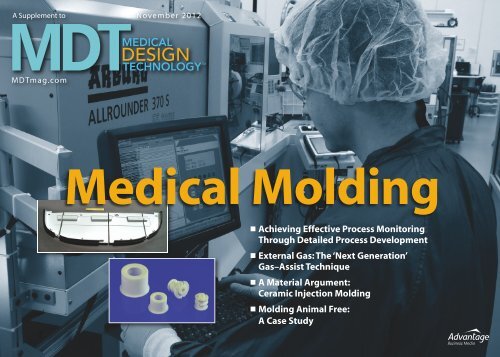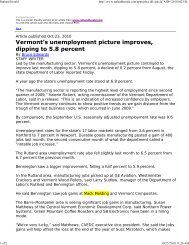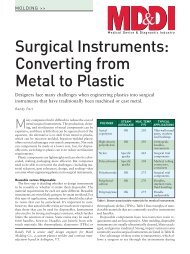Achieving Effective Process Monitoring Through ... - Mack Molding
Achieving Effective Process Monitoring Through ... - Mack Molding
Achieving Effective Process Monitoring Through ... - Mack Molding
Create successful ePaper yourself
Turn your PDF publications into a flip-book with our unique Google optimized e-Paper software.
A Supplement to<br />
November 2012<br />
MDTmag.com<br />
Medical <strong>Molding</strong><br />
<strong>Achieving</strong> <strong>Effective</strong> <strong>Process</strong> <strong>Monitoring</strong><br />
<strong>Through</strong> Detailed <strong>Process</strong> Development<br />
External Gas: The ‘Next Generation’<br />
Gas–Assist Technique<br />
A Material Argument:<br />
Ceramic Injection <strong>Molding</strong><br />
<strong>Molding</strong> Animal Free:<br />
A Case Study
Medical <strong>Molding</strong><br />
External Gas: The ‘Next<br />
Generation’ Gas–Assist<br />
Technique<br />
The advantages and benefits of external gas-assisted injection molding,<br />
how it compares to internal gas-assisted injection molding, and<br />
in-roads the process is making into medical device applications will<br />
be examined in this article. In addition, critical steps that form the<br />
basis of successful external gas application will be highlighted and<br />
real-life examples provided.<br />
Cosmetic surface<br />
(no sink marks)<br />
Melt injection<br />
(via cold sprue)<br />
Size: 42 x 18 x 3 (front & back)<br />
Flow leader<br />
(reduces tonnage)<br />
By Dr. Michael Hansen<br />
While external gas-assisted (EGA)<br />
injection molding has been<br />
around for some time, it has only<br />
recently burst onto the scene as<br />
the “next generation” molding technique for<br />
large parts. Why? It has been proven to cut costs,<br />
lower tonnage requirements, minimize warpage,<br />
improve overall part quality, and reduce or even<br />
eliminate secondary operations. Consequently,<br />
it is now being used for more and more applica-<br />
tion areas, including medical devices.<br />
First, review two short videos to better understand<br />
the internal and external gas-assist processes,<br />
including the sequence of steps, as well<br />
as similarities and differences (click here to view<br />
videos).<br />
The primary difference between the two<br />
techniques is the function of the gas in developing<br />
the part. While gas is injected into the core of<br />
the melted plastic with the internal method, the<br />
external gas technique adds a micro-thin layer<br />
of nitrogen gas to the surface adjacent to the<br />
cosmetic side of the part after the cavity has been<br />
filled with resin. The nitrogen gas layer packs the<br />
part evenly across the core surfaces. The pressurized<br />
gas replaces the holding phase, produces<br />
thicker ribs without sink marks, and results in an<br />
even, low-gloss surface on the cavity side of the<br />
part. It should be noted that this process does<br />
require a gas-tight seal between the core side of<br />
the tool and the molded plastic part.<br />
If EGA is chosen over internal gas-assist—a<br />
choice that can only be made after a thorough<br />
review of design, material, tooling, and processing<br />
considerations—there can be other significant<br />
advantages, including:<br />
MDT • Medical <strong>Molding</strong> Supplement 6 November 2012
Medical <strong>Molding</strong><br />
Application Resin Projected area<br />
[sq-in]<br />
• No “shadow marks” on cosmetic surfaces<br />
• Elimination of “fingering”—a defect resulting<br />
from gas that penetrates thinner-walled<br />
sections adjacent to the gas channels formed<br />
when using internal gas-assist<br />
• More even gas distribution, since internal gas<br />
pressure dissipates with increasing distance<br />
from the gas channel<br />
• No open holes for gas pin locations or overspills<br />
• Minimized knit lines and hesitation marks created<br />
by part design and/or flow patterns<br />
Additionally, the external and internal gas<br />
techniques can both be used in different sections<br />
of the same part, if appropriate.<br />
EGA offers several additional benefits, including:<br />
• No molded-in stress and warpage<br />
• No sink marks on visible cosmetic surfaces<br />
• Lower clamp force requirement, resulting in<br />
Clamp Force [tons]<br />
Tonnage<br />
[tons/sq-in]<br />
Blender PC/ABS 632 1,500 2.37<br />
Boiler Cover PC/ABS 1,200 1,500 1.25<br />
ATM Cover PC/ABS 195 300 1.53<br />
Cooling Unit<br />
ASA 1,760 3,000 1.70<br />
Base<br />
HVAC Unit<br />
PC 930 2,000 2.15<br />
Cover<br />
Front Panel PBT/PC 816 1,500 1.84<br />
significant press tonnage reduction and lower<br />
costs<br />
• Reduced wear on molds due to lower operating<br />
pressures<br />
• Reduced power consumption since smaller<br />
presses are used<br />
• More freedom in part design (rib-to-wall ratio<br />
can be 1:1 or even higher)<br />
• Consistent packing pressure<br />
Resulting parts are very similar in appearance<br />
to compression molded parts due to the assistance<br />
of the nitrogen gas layer.<br />
ADVANTAGES FOR MEDICAL<br />
APPLICATIONS<br />
The previously mentioned benefits are resulting<br />
in qualitative improvements and quantitative<br />
savings in medical device applications. The<br />
process is producing flatter parts for improved<br />
MDT • Medical <strong>Molding</strong> Supplement 7<br />
Quality a Given,<br />
Speed a Priority<br />
for medical molding<br />
and assembly<br />
• Turnkey service including product<br />
design and development, DFM,<br />
and prototyping<br />
• Production capabilities ranging<br />
from tooling and micro molding to<br />
multi-shot molding, insert molding,<br />
and continuous flow assembly lines<br />
• ISO Certified clean room<br />
production and validated sterile<br />
packaging<br />
www.junopacifi c.com
Medical <strong>Molding</strong><br />
Cosmetic surface<br />
(no sink marks)<br />
Melt injection<br />
(via cold sprue)<br />
Size: 46 x 26 x 3 (front & back)<br />
assembly and easier sealing and mating with<br />
other plastic and metal parts. Less molded-in<br />
stress improves chemical resistance, resulting<br />
in better long-term temperature behavior and<br />
longer part lifetimes. Lower tonnage requirements<br />
translate into reduced piece-part costs.<br />
Less warpage minimizes stress-cracking and<br />
improves part behavior under cyclic external<br />
loads and pressures. Additionally, thicker rib-towall<br />
ratios make it possible for more structural<br />
parts to be designed in plastic.<br />
Several critical steps must be taken to ensure<br />
Flow leader<br />
(reduces tonnage)<br />
the successful application<br />
of EGA:<br />
• Single-gate, if at all possible, to<br />
avoid knit lines<br />
• Adapt wall thickness and add<br />
flow leaders, if necessary, to fit<br />
the selected press size<br />
• Perform warpage analysis to<br />
minimize distortion<br />
• Select appropriate gate size<br />
and location<br />
• Determine exact shrinkage<br />
for tool build to achieve tight<br />
dimensional specifications for<br />
assembly<br />
• Add appropriate external<br />
gas features to both the part<br />
design and tool to allow for<br />
proper gas sealing<br />
Examples of required sealing features include<br />
incorporating a step on the outside parting line<br />
with grooves around bosses to create an outside<br />
seal, along with small ribs around internal openings<br />
to confine gas to the back side of the part<br />
and allow gas pressure build-up. This creates a<br />
balloon effect between the core side of the tool<br />
and the back side of the part. In order to achieve<br />
the pressure build-up, all ejector pins have to be<br />
sealed as well.<br />
The images accompanying this article are<br />
examples of applications that have recently<br />
been molded using EGA. All are used in the field<br />
unpainted. The heaviest is 15.3 lbs. The range of<br />
main wall thicknesses exceeds 0.2 in. The selected<br />
resins span the spectrum from low-to-high<br />
shrinkage amorphous resins, as well as semi-crystalline<br />
materials. The thicker gas channels in the<br />
parts are hollowed out by internal gas-assist. The<br />
general published tonnage range for the resins<br />
listed in the chart is 3 to 5 tons/sq-in. The maximum<br />
clamp force reduction for these applications<br />
ranges between 25% to just over 50% using the<br />
EGA process compared to the higher tonnage of 5<br />
tons/sq-in in straight injection molding.<br />
As illustrated in this article, there is growing<br />
potential for EGA in both new and redesigned<br />
applications of various sizes, wall thicknesses,<br />
and resins. If properly implemented, the process<br />
technique can advantageously impact cost, press<br />
tonnage requirements, warpage, overall part quality,<br />
and secondary operations.<br />
Michael Hansen, PhD is the senior technical<br />
development engineer for <strong>Mack</strong>Medical/<strong>Mack</strong><br />
<strong>Molding</strong> Co. He is responsible for developing<br />
new applications using advanced resins and<br />
processing techniques assisted by 3D filling<br />
simulation programs.<br />
MDT • Medical <strong>Molding</strong> Supplement






